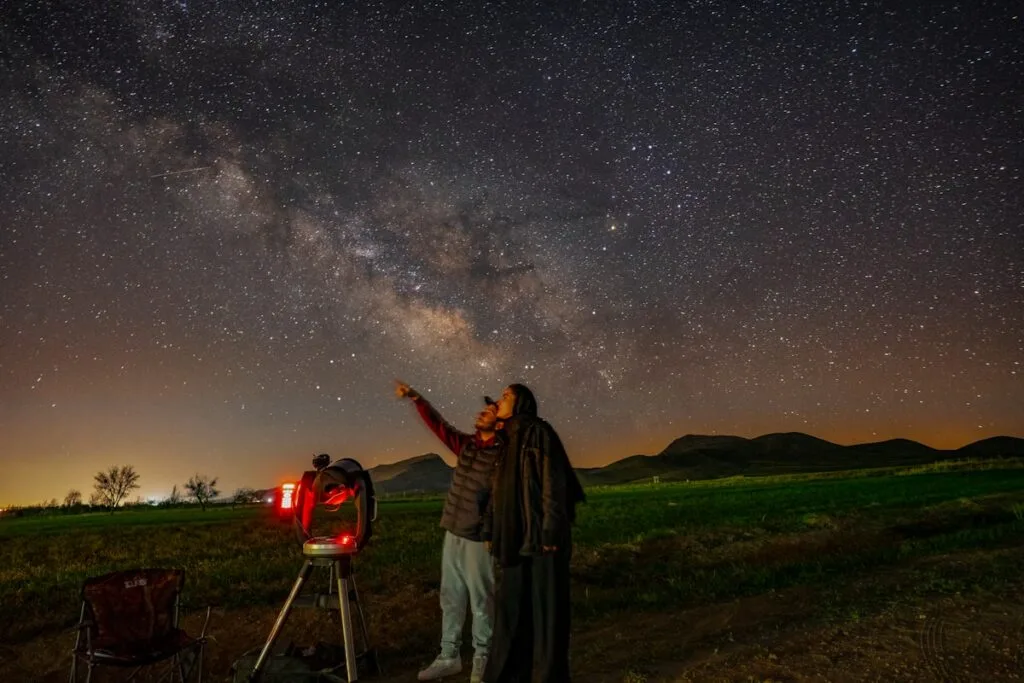Finding The City of Stars- A Celestial Show You Won’t Want to Miss
If you love looking up, April is the perfect time to reconnect with the universe. When you step outside, tilt your head back and start finding the City of Stars, a celestial show you won't want to miss - let the universe dazzle you again this month!

This April, the night sky transforms into a stage of cosmic wonder, offering breathtaking celestial sights for skywatchers. From gleaming planets parading across the horizon to the streaking brilliance of meteors and the quiet majesty of star clusters, the universe is putting on a show and you’ve got a front-row seat.
Your celestial show this month starts with a spectacular planetary lineup. Early risers are rewarded with views of Jupiter in the eastern skies just before sunrise, its presence shining like a beacon. In the evening, Venus makes her shimmering descent closer to the horizon, her brilliant light impossible to miss. Mars, ever the mysterious red planet, is visible too, adding a splash of colour to the twilight skies.

Mark your calendar for April 21–22, when the Lyrid meteor shower reaches its peak. Known for its fast, bright meteors, the Lyrids are one of the oldest recorded meteor showers observed for more than 2,600 years. With up to 20 meteors per hour under dark skies, it’s the perfect excuse to grab a blanket, head somewhere with less pollution and watch the sky come alive.
You might glimpse Jupiter’s largest moons or Mars’s subtle rusty hue. These planetary wonders are easy to spot with the naked eye. If you’ve got binoculars or a telescope, take a closer look.
The Ancient City of Stars, Canes Venatici
Tucked quietly into the northern sky, between the dazzling arcs of the Big Dipper and the winding constellation of Coma Berenices, lies one of the night’s lesser-known treasures: Canes Venatici, the hunting dogs of the heavens.
This small but fascinating constellation was first introduced in 1687 by Polish astronomer Johannes Hevelius, who imagined it as a pair of faithful hounds accompanying Boötes, the Herdsman, across the celestial plains. Though the stars forming Canes Venatici had previously been considered unremarkable or even left unnamed, Hevelius gave them a story—and in doing so, gave stargazers something new to discover.
The name Canes Venatici means “hunting dogs” in Latin. In Hevelius’s celestial maps, these two dogs are seen chasing the Great Bear (Ursa Major), led by their master, Boötes. It’s a poetic visual: a herdsman and his loyal companions, eternally sweeping through the stars in pursuit of mythological prey.
Unlike some of the grander, more prominent constellations, Canes Venatici doesn’t boast a wealth of bright stars. But its charm lies in its quiet, understated beauty and the cosmic treasures it contains.

Among Canes Venatici’s most spectacular sights is the globular cluster Messier 3 (M3). Containing more than 500,000 stars, many of them over 8 billion years old, M3 glows like a diamond-studded sphere in the dark sky.
It’s one of the most beautiful globular clusters observable from Earth and an absolute must-see for anyone with a telescope or a good pair of binoculars.
La Superba: A Star to Remember
Another standout in Canes Venatici is Y Canum Venaticorum, a carbon star famously nicknamed La Superba for its deep, ruby-red hue. This luminous, dying giant star burns with a fierce red that can even be spotted with binoculars, making it a favorite among amateur astronomers.
How to Find Canes Venatici
- Look to the northern sky in spring and early summer evenings.
- Find the Big Dipper, then follow the curve of its handle to locate Arcturus, the brightest star in Boötes.
- Just below the handle of the Big Dipper and slightly to the east of Arcturus lies Canes Venatici, a subtle grouping of stars forming a line or small triangle, depending on your perspective.

The next time you find yourself under a clear sky this April, take a moment to seek out Canes Venatici. You may just fall in love with its quiet charm, loyal symbolism, and the timeless companionship it offers to anyone who gazes upward with c
How to Make the Most of It
- Find a dark sky spot: Get away from city lights for the best views.
- Check the moon phase: A darker sky means better meteor and star cluster visibility. The moon will be in its waxing gibbous phase during the Lyrids, so plan your viewing before moonrise if possible.
- Download a stargazing app: Apps like Sky Guide or Stellarium can help you identify what you’re seeing and when to look.
- Bring friends and snacks: Stargazing is even better with good company and a thermos of hot chocolate.
Whether you’re a seasoned astronomer or simply love looking up, April is the perfect time to slow down and reconnect with the cosmos. Step outside, tilt your head back and let the universe dazzle you.
For more stargazing tips, celestial highlights, and cosmic inspiration, stay tuned to our monthly skywatch guide.
Do you want to share your story and inspire our readers ? Know that YOUR EXPERTISE is paving the way for a fairer, happier society.




